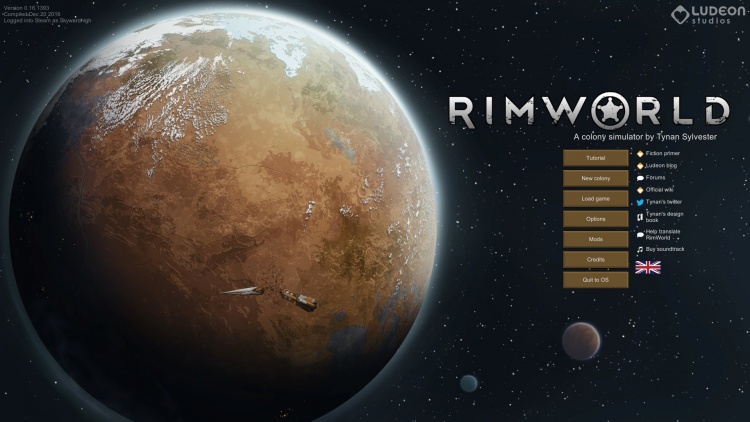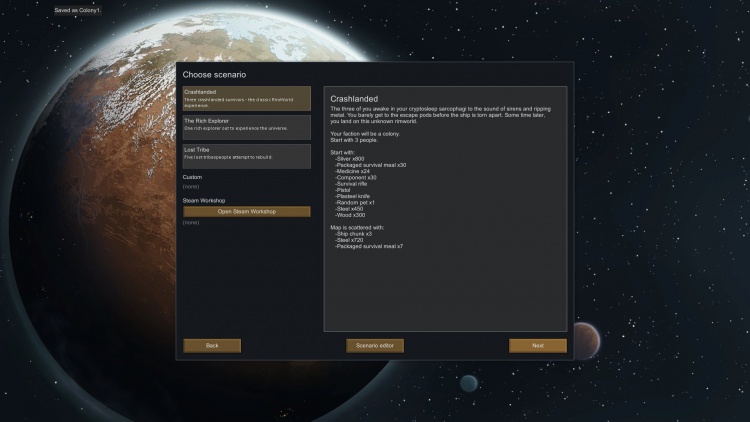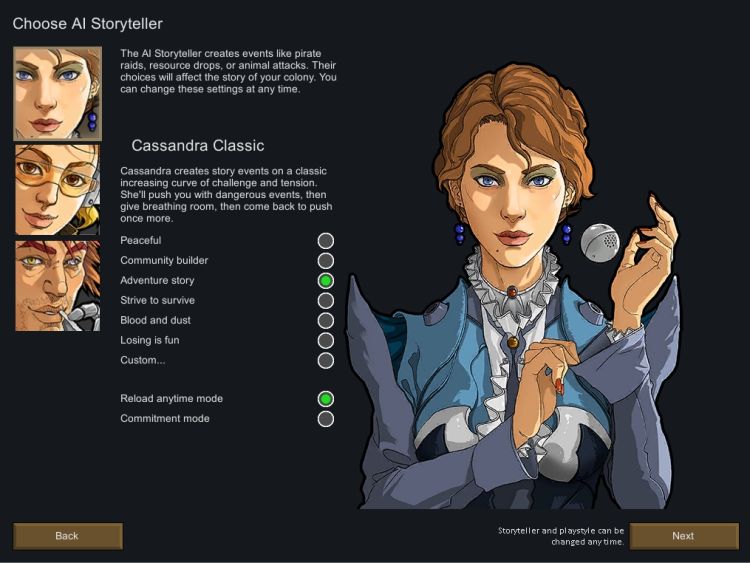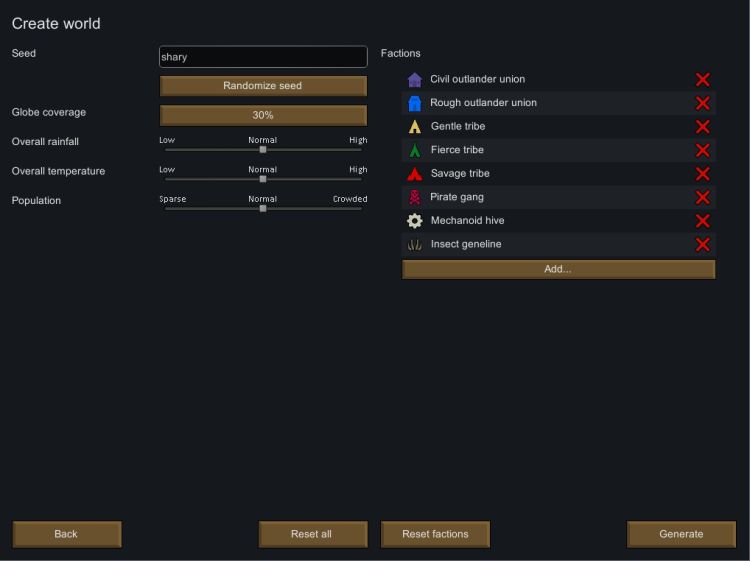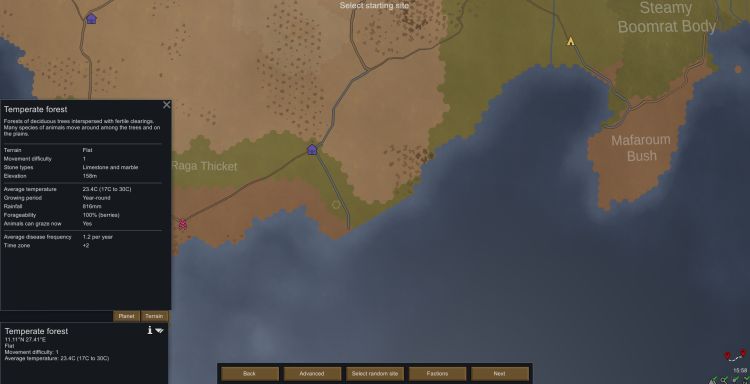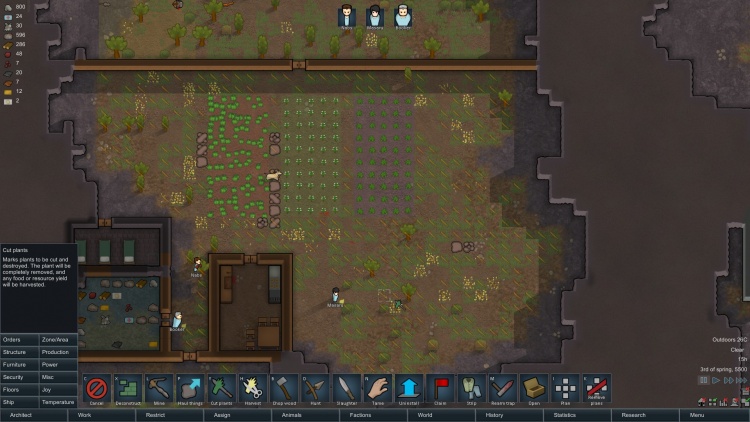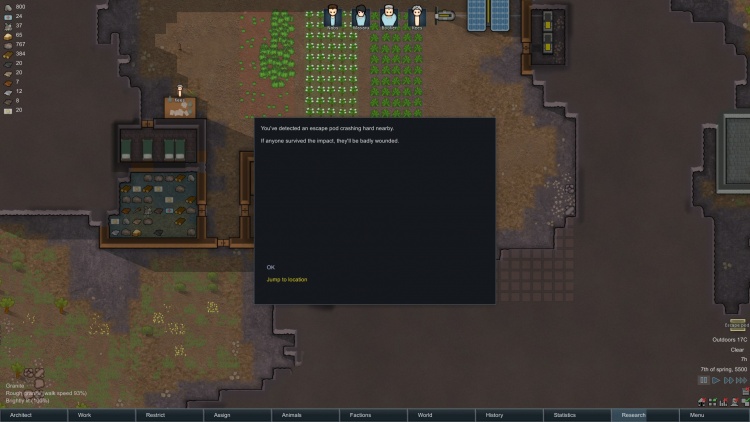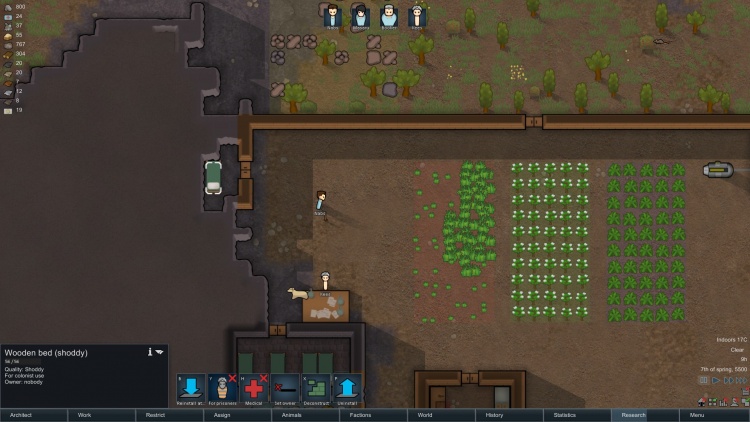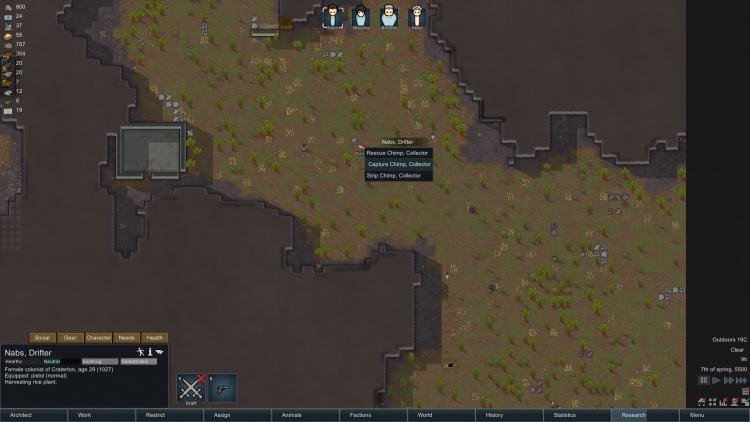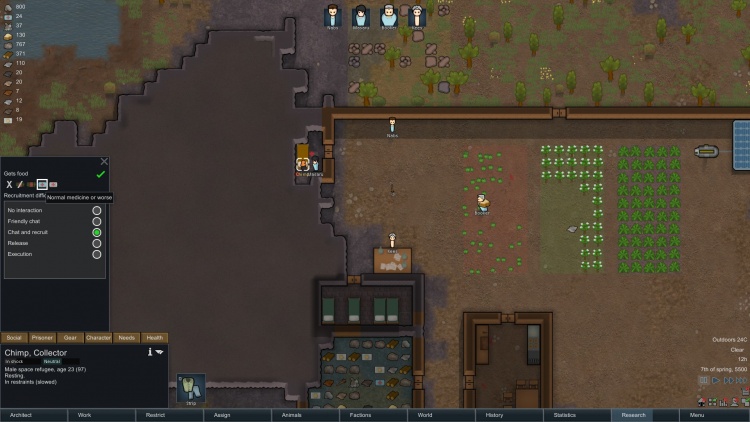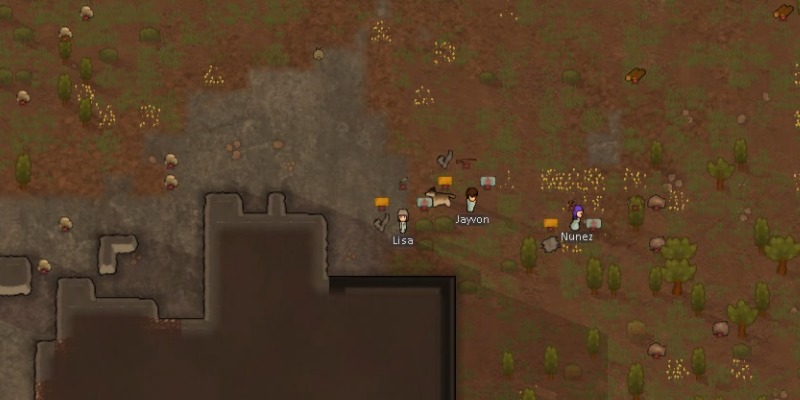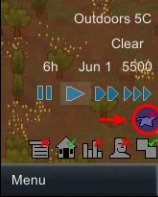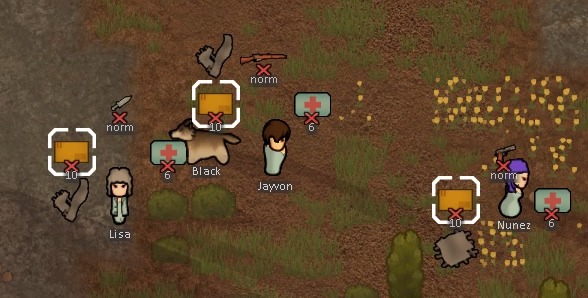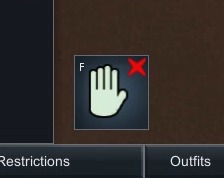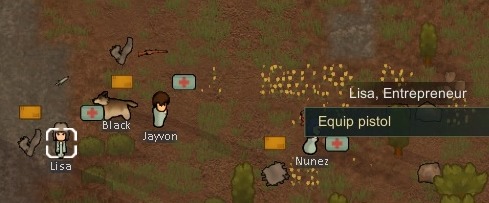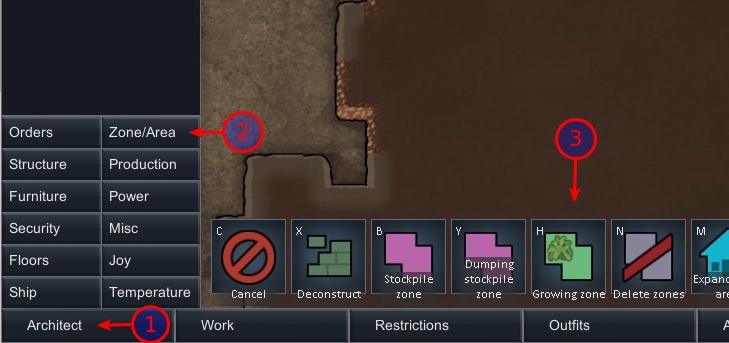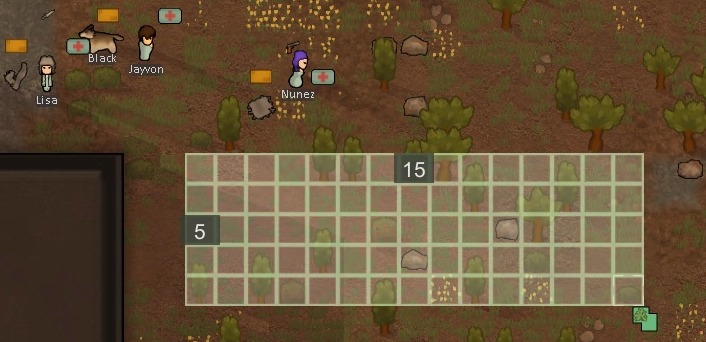Difference between revisions of "Basics"
(→So You Landed...: Made Subheading reside on its own line separate from the body of text.) |
Bellicosity (talk | contribs) (Updated starting images) |
||
| Line 19: | Line 19: | ||
== Game Startup == | == Game Startup == | ||
| − | [[File:Main Menu Basics.jpg| | + | [[File:Main Menu Basics.jpg|750px|alt=Main menu|The main menu, the first screen to after starting the game.]] |
Upon loading the game click on 'New Colony.' This will take you to the scenario selection screen. | Upon loading the game click on 'New Colony.' This will take you to the scenario selection screen. | ||
| − | [[File:Crashlanded Basics.jpg| | + | [[File:Crashlanded Basics.jpg|750px|alt=Alt description goes here|A more detail caption for under the image.]] |
For your first time playing, pick the standard crashlanded scenario. | For your first time playing, pick the standard crashlanded scenario. | ||
| − | [[File:Storyteller Basics.jpg| | + | [[File:Storyteller Basics.jpg|750px|alt=Alt description goes here|A more detail caption for under the image.]] |
The story teller decides how events will unfold during your playthrough of the game. Cassandra will try to time attacks/events in such a way that you can overcome them given your resources. Pheobe will do the same but far less frequently. Randy will give no care for your current state and will throw whatever he chooses to at you. | The story teller decides how events will unfold during your playthrough of the game. Cassandra will try to time attacks/events in such a way that you can overcome them given your resources. Pheobe will do the same but far less frequently. Randy will give no care for your current state and will throw whatever he chooses to at you. | ||
| Line 33: | Line 33: | ||
For your first playthrough, I would suggest Cassandra on either Rough or lower difficulty. If you have trouble with strategy or management games, consider Pheobe as well. | For your first playthrough, I would suggest Cassandra on either Rough or lower difficulty. If you have trouble with strategy or management games, consider Pheobe as well. | ||
| − | [[File:Create World Basics.jpg| | + | [[File:Create World Basics.jpg|750px|alt=Alt description goes here|A more detail caption for under the image.]] |
Next the game will ask you to generate a world. Simply click next and continue. | Next the game will ask you to generate a world. Simply click next and continue. | ||
| − | [[File:Landing Site Basics.jpg| | + | [[File:Landing Site Basics.jpg|750px|alt=Alt description goes here|A more detail caption for under the image.]] |
Picking your landing site is incredibly important. For a first time player I suggest Temperate Mountains with year round harvesting. This will give you a comfortable location to learn the game. | Picking your landing site is incredibly important. For a first time player I suggest Temperate Mountains with year round harvesting. This will give you a comfortable location to learn the game. | ||
| Line 64: | Line 64: | ||
Finally, look into their traits. Some traits are extremely toxic such as pyromaniacs whom will start fires when stressed or abrasive whom tend to start fights. | Finally, look into their traits. Some traits are extremely toxic such as pyromaniacs whom will start fires when stressed or abrasive whom tend to start fights. | ||
| − | [[File: | + | [[File:Character 1 Basics.jpg|750px]] |
| − | [[File: | + | [[File:Character 2 Basics.jpg|750px]] |
| − | [[File: | + | [[File:Character 3 Basics.jpg|750px]] |
== Starting the Game == | == Starting the Game == | ||
Revision as of 19:18, 20 July 2016
|
|---|
|
This article aims to teach you the basics of most of RimWorld's game systems. It should answer the question "ok, I landed, so what now?"
To illustrate the guide, I will show the progress from the first hour of a colony. The events will shown be roughly in order they happened, but quite a few things were actually happening in parallel.
Game Startup
Upon loading the game click on 'New Colony.' This will take you to the scenario selection screen.
For your first time playing, pick the standard crashlanded scenario.
The story teller decides how events will unfold during your playthrough of the game. Cassandra will try to time attacks/events in such a way that you can overcome them given your resources. Pheobe will do the same but far less frequently. Randy will give no care for your current state and will throw whatever he chooses to at you.
For your first playthrough, I would suggest Cassandra on either Rough or lower difficulty. If you have trouble with strategy or management games, consider Pheobe as well.
Next the game will ask you to generate a world. Simply click next and continue.
Picking your landing site is incredibly important. For a first time player I suggest Temperate Mountains with year round harvesting. This will give you a comfortable location to learn the game.
Colonist Selection
The three colonists you pick to start your game are vital to how well you intend on surviving. If you accidentally pick three colonists who are incapable of violence you will be in trouble when your turrets break and you have an assault on your hands.
For a first time player, you should be aiming to get all three colonists to be incapable of none. Additionally, one colonist should be proficient in the following skills:
- Social - Recruiting new colonists
- Medicine - Healing the colonists you have
- Cooking - Making food
- Construction - Building
- Growing - Growing/harvesting food
- Mining - Hollowing out mountains/hills
- Crafting - Creating clothing and other trade goods
- Research - Advancing your technology
You are aiming for 5+ on these skills on at least one character. 20 is the maximum for a skill.
It may be incredibly difficult to get a random group of three to meet these requirements. That is part of the game, and you may have to sacrifice a category or two. Additionally, a character who has a single or double fire for a category is attuned to that skill and will learn faster. Consider allowing a lower level character stay that has the fire for the skill you're looking for.
While picking your characters, also keep in mind their current health conditions. For example, older characters are frail and may die easier and asthmatic characters will require constant medical attention unless you give them lung transplants.
Finally, look into their traits. Some traits are extremely toxic such as pyromaniacs whom will start fires when stressed or abrasive whom tend to start fights.
Starting the Game
Early Scramble
You start crashlanded on an earthlike alien world.
After your three colonists land you will notice materials nearby and a pet of some sort.
The materials are as follows:
The individual resources are:
 Silver - A trade good. Consider this your form of money in the game
Silver - A trade good. Consider this your form of money in the game Wood - Simple construction material
Wood - Simple construction material Steel - Intermediate construction material
Steel - Intermediate construction material- Packaged Survival Meal (Error: Page does not exist) Packaged Survival Meals - Food that does not spoil
 Medicine - Material for healing colonists
Medicine - Material for healing colonists Components - Advanced construction material
Components - Advanced construction material
You may also find some materials scattered around the map.
Additionally you will find three weapons.
File:Shooting Skill Basics.jpg
You should immediately examine your colonists to see who is best suited for each weapon. A brawler should be given a melee weapon as they will get a negative mood modifier if they are using a ranged weapon. Afterwards, the best shot should be given the survival rifle and the remaining colonist the pistol. Give every colonist a weapon, even if that means giving a brawler a ranged weapon. You can make them a shiv later.
Once your colonists have equipped weapons start to unforbid the various materials near you. Do not go all over the map as it takes time for your colonists to retrieve them and you have more pressing things to do immediately. You can mass unforbid by double clicking on a single item then clicking 'F' or the button at the bottom left.
Forbidding an item tells all colonists not to touch it. This is useful when you have something you don't want them getting at. For instance, once you have a thriving food production set up it would be wise to forbid your Packaged Survival Meals as they never spoil and can be reserved for use in an emergency. Note that forbid does not work on animals or visitors.
Making a home
Food and shelter, your colonists primary concerns. Look around the area near to where you land and try to find some place that is defensible. Chokepoints (without water!) are good things to look for. Any preconstructed facilities are also a plus for helping you get set up quickly.
In this case I found a small valley to start my colony in with an almost constructed ruin. I filled in the gaps and threw down three beds for the colonists.
Be sure to place an animal sleeping spot indoors as well. Animals must be in these locations to receive medical care and you want to control where your animals sleep as well. If they sleep outdoors they run the risk of getting eaten or being subject to the weather.
File:Animal Sleeping Basics.jpg
Initial Farm Setup
Once you've established a base location, set aside some areas for farming. You will not need much land with year round growing. In this case I made three 5x10 plots. There are three basic food you can plant in Rimworld; Rice, Potatoes, and Corn. Rice grows quickly but is nutrient weak, Corn grows slowly but is nutrient dense, and Potatoes are the middle ground.
In this instance I threw down a plot of rice for quick cheap food, cotton for clothing, and potatoes for long term food production.
If you have a colonists with a farming skill at or above 8 you should also start growing healroot. It is a low tech variant to medicine that your colonists can use to heal each other. It is not as effective but better than nothing.
Work
Your colonists will all have tasks that need completion, but you will notice that some only work on certain things. This is controlled through the Work tab at the bottom. Once in the tab, mouse over a task name to see what that task covers.
You may be inclined to simply check all the boxes (a viable strategy for early game set up) but this is actually a poor decision to make long term.
The best situation is to start using the Manual Priorites (check box at the top right)
This will give you 5 degrees of priority for each task (1 - 4 and unassigned). Additionally tasks are prioritized left to right.
In this case, despite our colonist Booker having six tasks at priority level 1, the tasks on the left have a higher weight than the tasks on the right. For example, take a situation that had simultaneously a fire (Firefight), a prisoner requiring food (Warden), and a stone to be hauled (Hauling). Booker would fight the fire first, then feed the prisoner, then haul the stone. This is because all tasks are weighted left to right, so even marking everything at 1 has every task in an order. You break this left to right work priorities by assigning them different values.
A colonist will look at all level 1 tasks, left to right, to see if any need accomplishing. If the colonist cannot find a level 1 task that needs accomplishing, he/she will move onto any level 2 tasks, then 3, then 4. They will never work on any task that is unnumbered.
While setting up a colonists work priorities there are three visual cues that help give you an idea of this colonists suitability for the task. The first is the box outline itself for the number becomes brighter the more proficient a colonist is at the task. In this case, Booker is our best Warden, Nabs is our best Cook, and Masaru is our best Handler. The final two cues are the small fire marks in the bottom corner of a task box. These denote the colonists passion for the task, or how quickly they will learn it. A colonist with no passion learns at 33%, with a single passion at 100%, and with a double passion at 150%. Consider making colonists with low skill but high passions work their preferred task as they will skill up quickly.
...low skilled Doctors should ideally practice on prisoners...
Stockpiles
There are two types of stockpiles in the game (controlled through the Architect -> Zones). Dumping and Stockpile. They work similarly but have different uses. Stockpiles are for wanted goods, Dumping piles are for unwanted junk.
Start by creating a dumping stockpile a ways from your home (not too far though!). This can be out in the open. It will be initially used for dead animals, stone chunks, raider bodies, etc.
Then create a close by regular stockpile. Be sure to wall this one in and create a roofed area for it. Any items left out in the open will deteriorate over time so it is in your best interest to have a dry goods storage area.
Stockpiles have a huge number of settings you can tinker with to get the perfect set up. Ideally you will have quite a few littered around your base as the game progresses. One that is only for food capable of spoiling that houses them in a freezer, another for weapons and armor, another for building materials, another for trade goods, etc. To access the settings of a stockpile, click on the highlight it creates on the ground. If there is something in the way (ie, something being stored in that area) just click again and it will cycle through the items in that square.
Food Production
You should focus on creating a kitchen once you have the basics down. Colonists can eat raw food but they will become unhappy about it unless they are eating raw berries.
Find a nearby area and wall off enough to create a simple kitchen, table, and chairs.
You'll need only a butchers table and fueled cooking stove at first. The difference between a fueled cooking stove and a normal stove is that a fueled cooking stove is powered by wood and a normal stove uses electricity. Considering you do not have electricity set up, use the fueled stove first.
Be sure to throw down a table and some chairs for your colonists to eat at as they will get a negative mood modifier if they do not eat at a table.
Chairs can (and should) be placed at the work location for a bench as well, giving the colonist working at it a positive mood modifier for being comfortable. It is not a high priority but something that should be considered once you get established.
Making your first bill
A bill on a workbench or stove denotes a request for colonists to use that bench. Start by clicking on a bench then clicking 'Add Bill'
In this case I started with the stove. We need to ensure that our colonists always have food available. I like to set aside 5 items of food per colonist to start with, so click on the 'Do X Times' and it will give you the option to instead 'Do until you have X.'
This is useful for ensuring that we always have, in this case, 15 food prepared for our colonists. Its overkill at the moment, but it gets the job done.
For the butcher table, do the same thing but this time set it up to butcher creatures. You cannot cook a whole carcass, it has to be butchered first.
In this case we want to butcher every creature we kill, so go ahead and set it up to 'Do Forever.'
And now your food production is set. Your colonists will ensure there is at least 15 food set aside and all dead animals will be butchered for their meat/pelt.
Defenses
Always consider your defenses BEFORE you need them. Nothing is instant in Rimworld, so trying to scramble something last minute will be difficult.
Building a Wall
For now, we are going to create a simple exterior wall. This will help protect our colonists and animals inside from at least the animals outside and some external threats.
Now you cannot make Mexico pay for it, so you might need to chop down some wood for more material if necessary. Wood is the absolute worst structure building material (weak, flammable) but it should be plentiful in a temperate environment. You can do this through Architect -> Orders -> Chop Wood.
Before your workers finish building the wall to keep illegal immigrants raiders out make sure you let them know you don't want a roof over this area. Go to Architect -> Zones -> Enable No Roof Area
Roofs can collapse if not properly supported so it is in your best interest to deroof an area prior to deconstruction or in this case simply tell your colonists you do not want a roof there.
Practice Defense
Now select all your colonists and then click to 'Draft' them in the bottom right.
We're going to practice by killing all the random animals in our courtyard (DON'T KILL YOUR DOG!). With all the colonists selected move them someplace central. Deselect the melee individual, and instruct the other two to shoot at an animal by right clicking on it. Ensure you have some distance as some animals (bears, cougars, wolves, etc) are violent when attacked.
In the case of a violent animal, as soon as it becomes violent click on the animal. In the bottom left it will state which colonist the animal is charging. Start that colonist running away immediately from the main group and the animal. The other colonists should be able to still shoot at the animal while the chased colonists 'kites' it.
With all the animals dead in the yard, select them and unforbid their corpses so your cook will butcher them for meat/pelts.
If you have no animals in your yard I suggest practicing with an animal outside your yard to get the feel for how combat works. Something small like a squirrel or rabbit will do fine.
Fire Handling
Fire is a very real threat in Rimworld. The first thing you need to consider, especially building with wood, is how fire will spread through out your base.
In this case, mow your damn lawn.
Go to Architect -> Orders - Cut Plants and select all plants NOT part of your growing zones inside your courtyard. We want to remove all plants from growing inside as it is just kindling in the event of a lightning storm. Note that this will probably take some time and you will probably have to redo it a few times to get all the stragglers. You should also consider mowing a few tiles from your walls on the outside as well if you intend on keeping wood walls for any extended period of time. You can install wooden floors if you want to force no plants to grow there.
In the event you do get a fire there are two ways you can handle it.
- You can let the colonists handle it on their own. They will automatically put out fires inside your home zone (Architect -> Zones -> Home Area) so long as they are prioritized to do so. This can lead to rather haphazard fire fighting though, with colonists all over the place.
- You can draft your colonists and move them adjacent to a fire. While drafted a colonist will fight the fire and you can coordinate your efforts.
Trading
At some point you will be visited by nearby colonies/tribes. They might just pass by but occasionally they will be available for trade. You can see this by looking for a '?' above one of the visitor's heads.
Find your colonist with the best social and right click on that visitor to select the option to trade. Here you can see if you have anything you can sell or buy from them.
Small caravans are normally fairly light on the trade goods but some, like orbital trade ships, carry extensive goods including rare animals or additional colonists. It is wise to create a decent stockpile of silver in the event you find something useful from a trader.
Research
At some point you should consider building a research bench. Sooner rather than later, as there are some tech items that are fairly invaluable.
File:Build Research Basics.jpg
It can be built outdoors and does not require power. In this case I threw it near the bedroom.
Once completed click the Research tab in the bottom right and select the item you are going to start on. I chose stonecutting so I could upgrade the wooden walls to something a little less flammable.
File:Start Research Basics.jpg
If one of your colonists is prioritized to research they will spend some time at the bench researching. Again, it would be smart to give them a stool or chair to sit at.
Research takes time, especially for someone unskilled at an unpowered station. Start it early as you will need some items before you know it.
Power
All the advanced equipment runs on power. The best source of reliable power early game is the solar panel (always giving 100% during the day outside of events) but the wind turbine gives power at night. Both require batteries to ensure 100% uptime.
Find a nice out of the way area to set up some power generation. In this case I threw down a solar panel in the top right corner of my base.
I also created a small room to house our batteries nearby.
Be sure to tell your colonists to build a roof there if the area was previously set to a no roof area. Architect -> Zones -> Build Roof
You'll notice I left a small hole. Battery fires are bad. Really bad. Especially in a small contained area. The hole lets any heat vent out so that our colonists can safely fight the fire. Just ensure the hole is not over any battery as they can short circuit in the rain and explode.
Wind turbines require adequate clear space to run properly. No trees, walls, mountains, etc in their way. They can go over solar panels and fields though, so you can tightly pack three solar panels under a wind turbine if you chose.
Finally run a power line near what you want to connect to. Only batteries and power generating items require being directly connected. Everything else connects within a small radius. In this case, I put a light in the kitchen and the power line along the top of it is close enough to connect.
Raids
It will not take long for your first raid. Typically it is a single individual armed with a melee weapon. He may or may not immediately attack.
Once he does attack, draft your men and prepare them near where he will be coming from.
If you're lucky, you'll down him quickly.
Then click on him and evaluate his benefit if you tried to capture/recruit him.
In this case I decide against the raider because he is asthmatic and a pyro. We live in wooden houses people! No FIRE.
So I selected one of our melee colonists and instructed him to melee attack the raider until he died.
Once he is dead you need a place to put them. You have four real options.
- Bury them in a grave
- Place them in a dumping stockpile
- Cremate them (molotovs or a crematorium)
- Eat them (mood penalty for non-cannibals)
At this point in the game, your best bet is to just bury them. Set aside some graves outside your base.
Crashlanded Colonists
Occasionally you will get a space traveler who crash lands nearby. If after evaluating their skills you want them to join you, you can attempt to.
You will need to create a new room for a bed before you do so. I chose a small cave and walled it off.
Once the room and bed is complete, select the bed and set it for prisoners only. This will make it orange/yellow.
Finally select a colonist and right click on the crashlanded individual. You will have three options, Rescue, Capture, and Strip. Rescue is for catch and release and improves faction standings with whomever that person belongs to. Capture is to attempt to make them a prisoner to sell or recruit them. Strip is to take off all their clothes (you perv).
In this case, select 'Capture.'
Once he is place in a bed you will have a new tab for him labeled prisoner. Under this tab you can control his treatement.
You can select what type of medical treatment he receives, whether or not he is given food, and what kind of warden attention he is given. In this case, we want to give him food, medicine, and chat/recruit.
OLD MATERIAL
Preparation
Before you can start a game, you need to create a world and select a storyteller. I recommend Cassandra Classic on Basebuilder difficulty for the first time playing.
Choosing a landing site. The best landing sites for your first game are temperate regions with large hills or mountains, with everything else mattering little or best left at default.
Finding the right team. The big thing about team selection is which work your colonists can do. Since you start only with three people, you cannot afford to specialize in the beginning. Consequently, you best take people that can do every work, otherwise you might have only one or two people that can do a crucial task.
The second most important matter is age, with very old people often having health problems that interfere with most physical tasks. Conversely, though, they tend to have much higher skills than young people. I'd personally say that as long as you don't have only old people, you don't need to pay too much attention to that.
As for skills and traits, I find that they do not matter that much. If you like to micromanage your start and have a bit of an easier time, look for high growing, shooting, mining and cooking, as well as traits that give bonus to mood or reduce the mental break threshold, and avoid traits that do the opposite. But as I said, that is not necessary, and I'll show how to manage mood and prevent mental breaks below.
So You Landed...
Wait until all three colonists have landed, then press space to pause the game to have a look around. You can move the screen with the cursor keys as well as wasd and zoom with the mousewheel.
What's going on here? Well, there's our three colonists, who are surrounded by various things.
Let's first talk about the terrain: our colonists are next to a couple of hills. A black brick building has been built onto the hill closest to them. We cannot see the inside of the hills or building. The east and north are fertile soil with some flowers, grass, bushes and trees. There are a couple of patches of infertile rock ground in the east, not to be confused with the three patches of rock chunks on fertile ground in the north-west. To the very north-east, we can see two abandoned brick walls.
Next, there's a number of resources surrounding the landing site. They are currently being forbidden, as indicated by the red X at the bottom of each. The colonists won't interact with forbidden resources until you unforbid them.
The individual resources are:
 Silver
Silver Wood
Wood Steel
Steel- Packaged Survival Meal (Error: Page does not exist) Packaged Survival Meals
 Medicine
Medicine
There are also three weapons with a red X:
There are also three pieces of metal slag nearby, remnants of the escape pods your colonists came in. Eventually, you can turn them into usable steel, but for now they'll just be in the way.
Oh, and there is a dog.
A dog? As in a pet? Yes, you start with a pet! Clicking on the show animal names button in the bottom-right in fact tells us her name is Black.
What to do first? First, double click on one resource. This will select all resources of that type on screen. Press F or click the button with the hand in the lower-left corner of the screen to unforbid the resources. Repeat that for every resource. You don't need to unforbid the weapons.
Now select a colonist and right click on a weapon and select equip. Repeat that for all colonists. Be careful to not give a ranged weapon to a colonist with the brawler trait (the context menu will warn you), and make sure your best shooter gets the rifle. The colonists will go and get the weapons once you unpause the game.
About food and shelter. The first things your colonists need are simple: some food, and a bed to sleep in. To build anything, you need the architect menu at the very bottom-right of the screen.
Go to architect, then zones, then growing zone. Place a growing zone of about 15×5 in the fertile ground near your landing site.
Go to architect, then structure, then walls. This will show you a menu with all available resource types for the wall. Select wood. Place an about 13×7 building near the growing zone. Place two wooden doors in the wall near the growing zone. You can place doors right over the wall, you don't need to leave space for them.
Go to architect, then furniture, the bed. Select wood. Place three beds inside the building. Select animal sleeping spot from the same menu. Place one inside the building.
Assigning work.
Now we have a blueprint for our new home, but we still need to make sure our colonists are assigned to work properly.
At the bottom-left of the screen, next to the architect button, is the work button. Press it. Give every colonist a check mark in growing and give one of them a check mark in constructing. Choose the colonist who has the brightest box, as that means they have the biggest skill. As constructing is further to the left than growing, is has higher priority. As long as there is something to build, two of your colonists will sow potatoes and one will build your house, after which they all will sow.
Time is Passing
Now unpause the game (space).
How's everything going?
Research and skills.
Storage and deterioration.
Cleaning and hauling.
Resources and Expansion
Growing corn, chopping wood, mining steel.
Dining room and furniture quality.
Whoa, what just happened?
Visitors and refugees.
Medicine and treatment.
A basic defence.
A wealth of cargo.
A new colonist.
Becoming a true village
Single quarters.
Night owls and nudists.
Hunting and butchery.
Electricity and refrigeration.
A kitchen and proper meals.
Stone cutting and roads.
Sculpting, flowers and better rooms.
Trading.
Defending the village
A scrambled force.
Turrets everywhere.
Digging graves.
Old Content
When starting a new game, there are many things to do to get your colony up and running as it should and doing so with efficiency, but before that can happen, your colonists actually need to be alive. Your colonists will need food and at least some degree of comfort (e.g. Someone to talk to or a game), to give them some reprieve from the constant work that the early colony will almost certainly need. To fulfil these needs there are many means, and so we begin.
Food
Food is going to be required, no question about it. Be it raw beef or a fine meal, food will sate your colonists' need to eat, albeit at much different levels and amounts. Typically, meat and luxuries like chocolate and beer will be expensive (good luck sustaining a colony on candy), and good ole' grain cheap, both to produce and buy. Farming it will not always guarantee a good yield or adequate amount of food, but is a good mainstay of production. Here is a guide on how to start actually feeding the people you are responsible for and not just brushing away the insanity of hunger as a personal problem.
- Grains and Potatoes: These are the very simplest, basic crops that will serve to keep your colonists alive and well. They happen to be quite hardy and offer a good staple. Easy to grow, but note that some types like hotter weather (i.e. Rice) and some like colder (i.e. Corn). Very useful overall, and should be a mainstay. Do not usually decay very fast (Especially corn) so they can be stored easily.
- Fruit: Not recommended for starting out and don't bring a whole bunch to the table, but can be eaten raw without much or any penalty. Most can be harvested from the world around like agave plants or bushes, so they can be used when you need a little bit more to keep alive. Farming is temperamental but possible.
- Meat: Meat happens to be an odd case. You can easily get meat by hunting animals anywhere, and get more from larger animals, but take care that it will spoil quite fast. The quick spoilage makes this option not recommended for a staple but can supplant your main source. Refrigeration is hard to come by in a crude wood shack in the desert.
Comfort and Temperature
Now that your little people will not starve to death after the starting food runs out, let's get to keeping it that way sans mental breakdowns. The first thing to do is to build a small shack out of steel or wood, preferably near either a hill/mountain or geothermal vent for future expansion, and large enough to house all of your colonists. Put some beds out of any material you please (but wood is often cheaper and easier to build) and, if you feel really nice, add a plant pot or two. If you somehow fancy plopping your colonists on the north pole or a desert, you will have to deal with temperature immediately. For the colder climates, a small heater works magic when you have the electricity, but as of the moment you likely don't, so a camp fire will do. Remember that the shack should be enclosed with a door. Around 20-25 degrees C is good for comfort, but it always depends upon your colonists. If you decided to live in a fiery hell of a desert, then there is not much you can do off the bat except perhaps keeping indoors and in the cool. Once you have all this, power is helpful.
